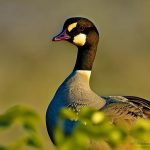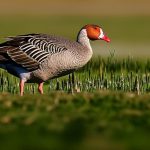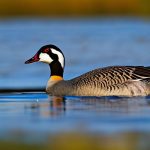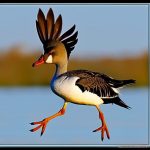Canadian geese are known for their strong migratory instincts and their tendency to return to the same nesting and feeding grounds year after year. They are social birds that often travel in large flocks and are highly adaptable to various environments. Canadian geese are herbivores and primarily feed on grasses, grains, and aquatic plants. They are also known to be territorial and protective of their nesting sites, often exhibiting aggressive behavior towards perceived threats.
Understanding the behavior of Canadian geese is crucial in developing effective strategies for deterring them from unwanted areas. By recognizing their migratory patterns, nesting habits, and feeding preferences, property owners can implement targeted deterrent methods to discourage geese from congregating on their land. Additionally, being aware of their territorial nature can help in devising non-confrontational approaches to managing geese populations without causing harm to the birds.
Canadian geese are intelligent creatures that can quickly adapt to changes in their environment, making it essential to employ a combination of deterrent methods to effectively discourage them from settling in unwanted areas. By understanding their behavior and habits, property owners can develop a comprehensive approach to geese management that is both humane and sustainable.
Key Takeaways
- Canadian geese are territorial and can become aggressive during nesting season
- Physical deterrents like fences and netting can prevent geese from accessing certain areas
- Sound and visual deterrents like predator decoys and distress calls can scare geese away
- Natural repellents like grape seed extract can discourage geese from staying in an area
- Professional help may be necessary for large-scale geese management projects
- Legal restrictions and ethical considerations should be taken into account when implementing deterrents
Implementing Physical Deterrents
Physical deterrents are a popular method for discouraging Canadian geese from congregating on private property. These deterrents can include barriers such as fences, netting, or other physical structures that prevent geese from accessing certain areas. Additionally, physical deterrents can also include the use of landscape modifications such as altering the terrain or installing obstacles that make it difficult for geese to land or nest.
One effective physical deterrent is the use of fencing to create a barrier between geese and the desired area. Fences can be constructed to surround bodies of water, lawns, or other areas where geese are prone to congregate. The height and design of the fence are important considerations, as Canadian geese are capable of flying over low barriers. Additionally, the installation of netting over bodies of water can prevent geese from landing and accessing the area.
Another physical deterrent method is the use of landscape modifications such as adding hedges, shrubs, or other vegetation that can create obstacles for geese. By strategically planting vegetation or altering the terrain, property owners can make it less appealing for geese to settle in certain areas. These modifications can disrupt the natural habitat of geese and discourage them from nesting or feeding on the property.
Utilizing Sound and Visual Deterrents
Sound and visual deterrents are effective tools for deterring Canadian geese from unwanted areas. These deterrents work by creating an environment that is uncomfortable or threatening for the birds, encouraging them to seek alternative locations. Sound deterrents can include devices that emit loud noises or distress calls of predatory birds, while visual deterrents can involve the use of reflective objects or predator decoys.
One common sound deterrent is the use of propane cannons or other noise-making devices that emit loud sounds at regular intervals. These devices mimic the sounds of natural predators or create unexpected noises that startle geese and encourage them to leave the area. Additionally, distress calls of predatory birds can be broadcasted to create a sense of danger for geese, prompting them to seek safety elsewhere.
Visual deterrents can also be effective in deterring Canadian geese from settling on private property. The use of reflective objects such as Mylar tape or predator decoys like plastic owls or coyotes can create a sense of unease for geese, making them less likely to stay in the area. These visual deterrents disrupt the sense of safety and security for geese, encouraging them to find alternative locations for nesting and feeding.
Creating a Barrier with Fencing or Netting
Creating a physical barrier with fencing or netting is an effective method for deterring Canadian geese from unwanted areas. Fences can be constructed to surround bodies of water, lawns, or other areas where geese are prone to congregate. The height and design of the fence are important considerations, as Canadian geese are capable of flying over low barriers. Additionally, the installation of netting over bodies of water can prevent geese from landing and accessing the area.
Fences should be constructed with materials that are durable and resistant to damage from weather and wildlife. Additionally, it is important to ensure that fences are properly installed and maintained to prevent gaps or weak points that could allow geese to bypass the barrier. Netting should also be securely fastened to prevent geese from accessing bodies of water or other areas where they may settle.
When creating a barrier with fencing or netting, it is important to consider the specific needs and behaviors of Canadian geese. By understanding their ability to fly and their nesting habits, property owners can design barriers that effectively deter geese from accessing certain areas. Additionally, regular maintenance and monitoring of fences and netting are essential to ensure their continued effectiveness in deterring geese.
Using Natural Repellents
Natural repellents can be an effective and environmentally friendly method for deterring Canadian geese from unwanted areas. These repellents work by creating an environment that is unappealing or uncomfortable for geese, encouraging them to seek alternative locations for nesting and feeding. Natural repellents can include the use of plant-based oils, taste aversions, or other natural substances that deter geese without causing harm to the birds.
One common natural repellent is the use of plant-based oils such as grape seed oil or methyl anthranilate, which create a surface that is slippery and unappealing for geese to land on. These oils can be applied to grassy areas or bodies of water where geese are prone to congregate, making it difficult for them to access these spaces. Additionally, taste aversions such as bittering agents can be applied to vegetation or other surfaces to discourage geese from feeding in certain areas.
Another natural repellent method is the use of natural substances such as garlic or chili pepper spray, which create an unpleasant odor or taste for geese. These substances can be applied to vegetation or other surfaces to deter geese from feeding on the property. Additionally, natural repellents can also include the use of visual deterrents such as predator decoys or reflective objects that disrupt the sense of safety for geese.
Seeking Professional Help

In some cases, property owners may find it necessary to seek professional help in managing Canadian geese populations on their land. Professional wildlife management companies or environmental consultants can provide expertise in developing comprehensive strategies for deterring geese without causing harm to the birds or the environment. These professionals can conduct site assessments, develop tailored management plans, and implement effective deterrent methods based on the specific needs of the property.
Professional help may also be necessary in obtaining permits or approvals for certain deterrent methods, especially in cases where legal restrictions or ethical considerations apply. Wildlife management professionals can navigate the regulatory requirements and ensure that all deterrent methods are compliant with local laws and regulations. Additionally, they can provide ongoing monitoring and maintenance of deterrent systems to ensure their continued effectiveness in deterring geese.
When seeking professional help for managing Canadian geese populations, it is important to choose reputable and experienced wildlife management companies or consultants. These professionals should have a proven track record in implementing humane and sustainable strategies for deterring geese without causing harm to the birds or the environment. By working with knowledgeable experts, property owners can effectively manage geese populations while maintaining ethical and legal compliance.
Understanding Legal Restrictions and Ethical Considerations
When implementing deterrent methods for managing Canadian geese populations, it is important to consider legal restrictions and ethical considerations that may apply. In many jurisdictions, Canadian geese are protected under wildlife conservation laws, making it necessary to obtain permits or approvals for certain deterrent methods. Property owners should familiarize themselves with local regulations and seek professional guidance in navigating the legal requirements for managing geese populations.
Additionally, ethical considerations should be taken into account when implementing deterrent methods for deterring Canadian geese. It is important to prioritize humane and non-lethal approaches that do not cause harm to the birds or disrupt their natural behaviors. Property owners should consider the potential impact of deterrent methods on other wildlife species and the surrounding environment, ensuring that their strategies are sustainable and environmentally responsible.
By understanding legal restrictions and ethical considerations, property owners can develop comprehensive strategies for managing Canadian geese populations that are compliant with local laws and regulations. By prioritizing humane and sustainable approaches, property owners can effectively deter geese from unwanted areas while maintaining respect for wildlife conservation and environmental stewardship.
If you’re looking for ways to keep Canadian geese off your lawn, you may also be interested in learning about the dietary needs of geese. Check out this informative article on “Can Geese Eat Chicken Feed?” to understand what geese can and cannot consume, which can help you make informed decisions about how to manage their presence on your property.
Meet Walter, the feathered-friend fanatic of Florida! Nestled in the sunshine state, Walter struts through life with his feathered companions, clucking his way to happiness. With a coop that’s fancier than a five-star hotel, he’s the Don Juan of the chicken world. When he’s not teaching his hens to do the cha-cha, you’ll find him in a heated debate with his prized rooster, Sir Clucks-a-Lot. Walter’s poultry passion is no yolk; he’s the sunny-side-up guy you never knew you needed in your flock of friends!







